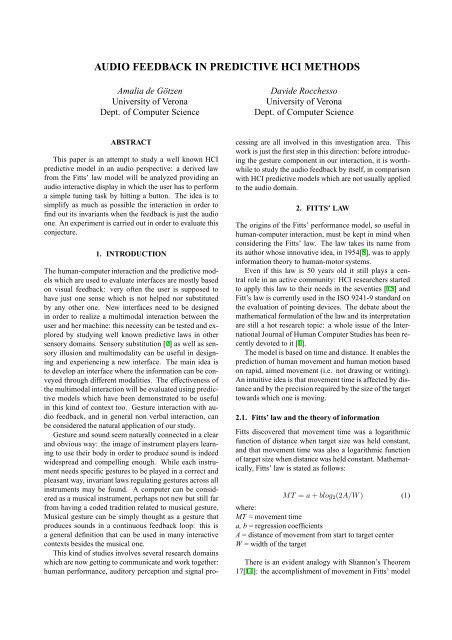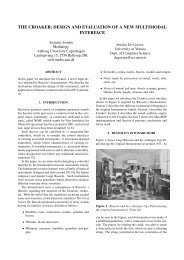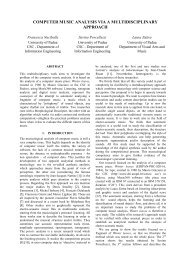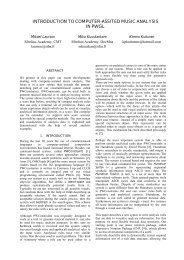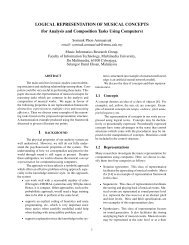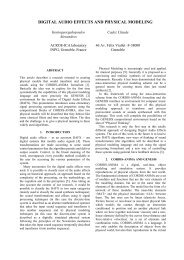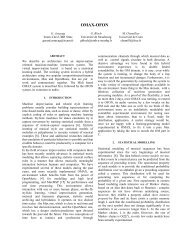audio feedback in predictive hci methods - Sound and Music ...
audio feedback in predictive hci methods - Sound and Music ...
audio feedback in predictive hci methods - Sound and Music ...
You also want an ePaper? Increase the reach of your titles
YUMPU automatically turns print PDFs into web optimized ePapers that Google loves.
AUDIO FEEDBACK IN PREDICTIVE HCI METHODS<br />
Amalia de Götzen<br />
University of Verona<br />
Dept. of Computer Science<br />
ABSTRACT<br />
This paper is an attempt to study a well known HCI<br />
<strong>predictive</strong> model <strong>in</strong> an <strong>audio</strong> perspective: a derived law<br />
from the Fitts’ law model will be analyzed provid<strong>in</strong>g an<br />
<strong>audio</strong> <strong>in</strong>teractive display <strong>in</strong> which the user has to perform<br />
a simple tun<strong>in</strong>g task by hitt<strong>in</strong>g a button. The idea is to<br />
simplify as much as possible the <strong>in</strong>teraction <strong>in</strong> order to<br />
f<strong>in</strong>d out its <strong>in</strong>variants when the <strong>feedback</strong> is just the <strong>audio</strong><br />
one. An experiment is carried out <strong>in</strong> order to evaluate this<br />
conjecture.<br />
1. INTRODUCTION<br />
The human-computer <strong>in</strong>teraction <strong>and</strong> the <strong>predictive</strong> models<br />
which are used to evaluate <strong>in</strong>terfaces are mostly based<br />
on visual <strong>feedback</strong>: very often the user is supposed to<br />
have just one sense which is not helped nor substituted<br />
by any other one. New <strong>in</strong>terfaces need to be designed<br />
<strong>in</strong> order to realize a multimodal <strong>in</strong>teraction between the<br />
user <strong>and</strong> her mach<strong>in</strong>e: this necessity can be tested <strong>and</strong> explored<br />
by study<strong>in</strong>g well known <strong>predictive</strong> laws <strong>in</strong> other<br />
sensory doma<strong>in</strong>s. Sensory substitution [2] as well as sensory<br />
illusion <strong>and</strong> multimodality can be useful <strong>in</strong> design<strong>in</strong>g<br />
<strong>and</strong> experienc<strong>in</strong>g a new <strong>in</strong>terface. The ma<strong>in</strong> idea is<br />
to develop an <strong>in</strong>terface where the <strong>in</strong>formation can be conveyed<br />
through different modalities. The effectiveness of<br />
the multimodal <strong>in</strong>teraction will be evaluated us<strong>in</strong>g <strong>predictive</strong><br />
models which have been demonstrated to be useful<br />
<strong>in</strong> this k<strong>in</strong>d of context too. Gesture <strong>in</strong>teraction with <strong>audio</strong><br />
<strong>feedback</strong>, <strong>and</strong> <strong>in</strong> general non verbal <strong>in</strong>teraction, can<br />
be considered the natural application of our study.<br />
Gesture <strong>and</strong> sound seem naturally connected <strong>in</strong> a clear<br />
<strong>and</strong> obvious way: the image of <strong>in</strong>strument players learn<strong>in</strong>g<br />
to use their body <strong>in</strong> order to produce sound is <strong>in</strong>deed<br />
widespread <strong>and</strong> compell<strong>in</strong>g enough. While each <strong>in</strong>strument<br />
needs specific gestures to be played <strong>in</strong> a correct <strong>and</strong><br />
pleasant way, <strong>in</strong>variant laws regulat<strong>in</strong>g gestures across all<br />
<strong>in</strong>struments may be found. A computer can be considered<br />
as a musical <strong>in</strong>strument, perhaps not new but still far<br />
from hav<strong>in</strong>g a coded tradition related to musical gesture.<br />
<strong>Music</strong>al gesture can be simply thought as a gesture that<br />
produces sounds <strong>in</strong> a cont<strong>in</strong>uous <strong>feedback</strong> loop: this is<br />
a general def<strong>in</strong>ition that can be used <strong>in</strong> many <strong>in</strong>teractive<br />
contexts besides the musical one.<br />
This k<strong>in</strong>d of studies <strong>in</strong>volves several research doma<strong>in</strong>s<br />
which are now gett<strong>in</strong>g to communicate <strong>and</strong> work together:<br />
human performance, auditory perception <strong>and</strong> signal pro-<br />
Davide Rocchesso<br />
University of Verona<br />
Dept. of Computer Science<br />
cess<strong>in</strong>g are all <strong>in</strong>volved <strong>in</strong> this <strong>in</strong>vestigation area. This<br />
work is just the first step <strong>in</strong> this direction: before <strong>in</strong>troduc<strong>in</strong>g<br />
the gesture component <strong>in</strong> our <strong>in</strong>teraction, it is worthwhile<br />
to study the <strong>audio</strong> <strong>feedback</strong> by itself, <strong>in</strong> comparison<br />
with HCI <strong>predictive</strong> models which are not usually applied<br />
to the <strong>audio</strong> doma<strong>in</strong>.<br />
2. FITTS’ LAW<br />
The orig<strong>in</strong>s of the Fitts’ performance model, so useful <strong>in</strong><br />
human-computer <strong>in</strong>teraction, must be kept <strong>in</strong> m<strong>in</strong>d when<br />
consider<strong>in</strong>g the Fitts’ law. The law takes its name from<br />
its author whose <strong>in</strong>novative idea, <strong>in</strong> 1954[5], was to apply<br />
<strong>in</strong>formation theory to human-motor systems.<br />
Even if this law is 50 years old it still plays a central<br />
role <strong>in</strong> an active community: HCI researchers started<br />
to apply this law to their needs <strong>in</strong> the seventies [15] <strong>and</strong><br />
Fitt’s law is currently used <strong>in</strong> the ISO 9241-9 st<strong>and</strong>ard on<br />
the evaluation of po<strong>in</strong>t<strong>in</strong>g devices. The debate about the<br />
mathematical formulation of the law <strong>and</strong> its <strong>in</strong>terpretation<br />
are still a hot research topic: a whole issue of the International<br />
Journal of Human Computer Studies has been recently<br />
devoted to it [1].<br />
The model is based on time <strong>and</strong> distance. It enables the<br />
prediction of human movement <strong>and</strong> human motion based<br />
on rapid, aimed movement (i.e. not draw<strong>in</strong>g or writ<strong>in</strong>g).<br />
An <strong>in</strong>tuitive idea is that movement time is affected by distance<br />
<strong>and</strong> by the precision required by the size of the target<br />
towards which one is mov<strong>in</strong>g.<br />
2.1. Fitts’ law <strong>and</strong> the theory of <strong>in</strong>formation<br />
Fitts discovered that movement time was a logarithmic<br />
function of distance when target size was held constant,<br />
<strong>and</strong> that movement time was also a logarithmic function<br />
of target size when distance was held constant. Mathematically,<br />
Fitts’ law is stated as follows:<br />
MT = a + blog2(2A/W) (1)<br />
where:<br />
MT = movement time<br />
a, b = regression coefficients<br />
A = distance of movement from start to target center<br />
W = width of the target<br />
There is an evident analogy with Shannon’s Theorem<br />
17[14]: the accomplishment of movement <strong>in</strong> Fitts’ model
is analogous to the transmission of “<strong>in</strong>formation” <strong>in</strong> electronic<br />
systems; movements have an <strong>in</strong>dex of difficulty which<br />
can be expressed <strong>in</strong> bits <strong>and</strong> the motor system transmit<br />
“bits of <strong>in</strong>formation” while mov<strong>in</strong>g. To explicitly show<br />
the formal derivation above mentioned, we pick up Shannon’s<br />
formula:<br />
C = Blog2(S/N + 1) (2)<br />
where:<br />
C = <strong>in</strong>formation capacity[bits/s] of the channel<br />
B = b<strong>and</strong>width[Hz] of the channel, the counterpart of 1/MT<br />
S = signal<br />
N = noise<br />
Here lies the <strong>in</strong>novative aspect of Fitts’ law: a quantitative<br />
way to measure the difficulty of a motor task becomes<br />
available through it <strong>and</strong> a “new” way to transmit<br />
<strong>in</strong>formation is implicitly described through the def<strong>in</strong>ition<br />
of a human channel. Fitts def<strong>in</strong>ed also some other <strong>in</strong>dexes<br />
that clarify the analogy with the Shannon formulation:<br />
ID = log2(2A/W) (3)<br />
IP = ID/MT (4)<br />
Where ID is the <strong>in</strong>dex of difficulty while IP is the<br />
<strong>in</strong>dex of performance, analogous to channel capacity C.<br />
[8] features a detailed analysis of all the variations on<br />
Fitts’ law, (i.e., Welford, MacKenzie formulation) derived<br />
from the need to correct the approximation by Fitts of the<br />
Shannon theorem, avoid<strong>in</strong>g:<br />
1. the theoretical problem of a negative rat<strong>in</strong>g for task<br />
difficulty,<br />
2. the problem of the disproportion of the relative contribution<br />
of A <strong>and</strong> W <strong>in</strong> the prediction equation:<br />
similar changes <strong>in</strong> target amplitude <strong>and</strong> target width<br />
don’t affect similar but <strong>in</strong>verse changes <strong>in</strong> movement<br />
time, as suggested <strong>in</strong> the orig<strong>in</strong>al Fitts formulation<br />
Skipp<strong>in</strong>g the detailed analysis of the data performed by<br />
MacKenzie, the f<strong>in</strong>al result by direct analogy to the Shannon<br />
formula is shown <strong>in</strong> 5. This is also the most frequently<br />
used one because of its better fit with empirical data.<br />
MT = a + blog2(A/W + 1) (5)<br />
2.2. Fitts’ law <strong>and</strong> dynamic systems<br />
The <strong>in</strong>formation theory is a way to describe the derivation<br />
of Fitts’ law, but a few others are possible[11, 10]. In<br />
particular the first order lag can be used as a model for human<br />
movement [4]: it can provide a basis for predict<strong>in</strong>g<br />
both movement time <strong>and</strong> also the time history of movement.<br />
The response of the first-order lag to a step <strong>in</strong>put of<br />
amplitude A with a ga<strong>in</strong> factor k, can be shown to be:<br />
Output = A − Ae −kt<br />
(6)<br />
The solution of the previous equation is the time that it<br />
would take the first-order lag to cross <strong>in</strong>to the target region.<br />
As shown <strong>in</strong> [11] the result is:<br />
ln2<br />
k<br />
2A<br />
log2( ) = t (7)<br />
W<br />
The similarities with Fitts’ law are quite evident: this is<br />
a logarithmic relation <strong>in</strong> which the movement time is directly<br />
proportional to the amplitude <strong>and</strong> <strong>in</strong>versely proportional<br />
to the target width. Though the similarity is strik<strong>in</strong>g,<br />
the second order system seems to provide a better fit for<br />
the velocity profile for human movements (a gradual <strong>in</strong>crease<br />
<strong>in</strong> velocity) <strong>and</strong> for Fitts’ law as well [7]. Both first<br />
<strong>and</strong> second order lags can be considered as cont<strong>in</strong>uous<br />
control <strong>methods</strong>: the error is cont<strong>in</strong>uously monitored <strong>and</strong><br />
the adjustment is provided accord<strong>in</strong>g to the detected error.<br />
Another possible model to expla<strong>in</strong> the derivation of Fitts’<br />
law is a system which can provide discrete control: such<br />
iterative correction model is proposed by Crossman [4].<br />
This model is also shown to be consistent with Fitts’ law.<br />
Fitts’ law is a very open field: considerable work has been<br />
carried out <strong>in</strong> HCI on the Fitts’ law model [8, 3, 16] but<br />
the literature on Fitts’ law with sound <strong>feedback</strong> appears<br />
to be very scarce [17, 6, 9, 6]. This <strong>in</strong>vestigation is also<br />
suggested by the big role played by multi-modality <strong>and</strong><br />
multi-sensory communication <strong>in</strong> the design of next generation<br />
<strong>in</strong>terfaces: non-speech communication will play an<br />
important role <strong>in</strong>side the <strong>in</strong>formation stream established<br />
between mach<strong>in</strong>es <strong>and</strong> users.<br />
3. SCHMIDT LAW: THE LINEAR<br />
SPEED/ACCURACY TRADE OFF<br />
This paper <strong>in</strong>vestigates the Schmidt law [13] which is often<br />
studied <strong>in</strong> comparison with the Fitts’ law: the ma<strong>in</strong><br />
difference between the two approaches is that Fitts treated<br />
movement amplitude <strong>and</strong> target width as <strong>in</strong>dependent variables<br />
<strong>and</strong> movement time (MT) as a dependent variable,<br />
while Schmidt chose to manipulate amplitude <strong>and</strong> movement<br />
time <strong>and</strong> to measure the movement variability of the<br />
effective target.<br />
In the Schmidt case, the tradeoff, formally the impulse<br />
variability model, forecasts that the st<strong>and</strong>ard deviation <strong>in</strong><br />
end-po<strong>in</strong>t coord<strong>in</strong>ates (viz., accuracy), is a l<strong>in</strong>ear function<br />
of velocity, calculated as distance over time:<br />
We = a + bA/MT (8)<br />
It is <strong>in</strong>terest<strong>in</strong>g to note that the previous equation <strong>and</strong><br />
Fitts’ law conta<strong>in</strong> the same three parameters (except that<br />
We is the st<strong>and</strong>ard deviation of end-po<strong>in</strong>t coord<strong>in</strong>ates <strong>and</strong><br />
is 4.133 × SD <strong>in</strong> Fitts’ adjusted model). Although this<br />
equation can be rearranged with MT as the predicted variable,<br />
it is still fundamentally different from the Fitts’ law<br />
s<strong>in</strong>ce the relationship is l<strong>in</strong>ear rather than logarithmic, <strong>and</strong><br />
because the <strong>in</strong>formation-theoretic analogy is absent. This<br />
l<strong>in</strong>ear trade off can be expla<strong>in</strong>ed us<strong>in</strong>g two hypothesis:<br />
• the movement-brevity hypothesis
Figure 1. Software environment<br />
• the temporal precision hypothesis<br />
It seemed <strong>in</strong>terest<strong>in</strong>g for our research to <strong>in</strong>vestigate this<br />
law with <strong>audio</strong> <strong>feedback</strong> s<strong>in</strong>ce temporal constra<strong>in</strong>ts are<br />
very often present when we are deal<strong>in</strong>g with music <strong>and</strong><br />
performance tasks.<br />
The aim of this paper was to explore the speed/accuracy<br />
trade off when there are temporal constra<strong>in</strong>ts <strong>in</strong> order to<br />
discover if the Schmidt law is still reliable with <strong>audio</strong><br />
<strong>feedback</strong>. This can be a first step <strong>in</strong> the <strong>in</strong>vestigation of<br />
Fitts’ law <strong>in</strong> an <strong>audio</strong> perspective: it seems easier <strong>and</strong><br />
more natural to start without <strong>in</strong>volv<strong>in</strong>g multimodal <strong>feedback</strong><br />
by just try<strong>in</strong>g to figure out if it is possible to apply<br />
HCI models designed for visual <strong>feedback</strong> to <strong>audio</strong> <strong>feedback</strong><br />
too. In this experiment the variables have been reduced<br />
as much as possible: the only th<strong>in</strong>g that we want to<br />
observe is the response of our hear.<br />
4. EXPERIMENT<br />
4.1. Participants <strong>and</strong> stimuli<br />
Ten subjects (between 26 <strong>and</strong> 48 years old) participated<br />
<strong>in</strong> the experiment perform<strong>in</strong>g 24 trials. All participants<br />
reported normal hear<strong>in</strong>g <strong>and</strong> sight, <strong>and</strong> normal motor capabilities<br />
<strong>in</strong> their h<strong>and</strong>s. All of them were naive as to the<br />
purpose <strong>and</strong> hypotheses of the test <strong>and</strong> all of them volunteered.<br />
The test has been done us<strong>in</strong>g Pure Data software<br />
<strong>and</strong> the user <strong>in</strong>terface is shown <strong>in</strong> fig. 1.<br />
4.2. Procedure <strong>and</strong> design<br />
Auditory stimuli were obta<strong>in</strong>ed us<strong>in</strong>g simple pure tones:<br />
the user has to reach a target frequency from a start<strong>in</strong>g one.<br />
The 8 different tasks which correspond to 8 different <strong>in</strong>tervals<br />
<strong>in</strong> 4 different frequency ranges have to be performed<br />
at different speeds (time constra<strong>in</strong>ts). The <strong>in</strong>tervals have<br />
been chosen <strong>in</strong> order to be non-musical <strong>in</strong>tervals <strong>and</strong> to<br />
explore the whole audible spectrum. For each <strong>in</strong>terval the<br />
user will start tra<strong>in</strong><strong>in</strong>g his hear: she/he will hear the start<strong>in</strong>g<br />
frequency, the f<strong>in</strong>al frequency (the target) <strong>and</strong> then the<br />
gliss<strong>and</strong>o performed with a given speed. After that he will<br />
start to perform the test. The user does not have any k<strong>in</strong>d<br />
of visual <strong>feedback</strong> <strong>and</strong> she/he has to just press a button <strong>in</strong><br />
order to start <strong>and</strong> stop the frequency which she/he is controll<strong>in</strong>g<br />
while is cont<strong>in</strong>uously hear<strong>in</strong>g the target frequency<br />
which is the frequency that she/he has to reach. Table 1<br />
Initial freq. F<strong>in</strong>al freq<br />
(Hz) (Hz)<br />
340 1310<br />
340 2430<br />
340 3270<br />
1240 2510<br />
1240 3700<br />
2170 3580<br />
2170 4000<br />
3300 4020<br />
Table 1. Initial <strong>and</strong> target frequency of each trial<br />
Figure 2. Data collected<br />
shows the list of <strong>in</strong>tervals that have been used for the three<br />
different speeds.<br />
4.3. Data analysis<br />
In fig. 2 all the data collected from one subject are plotted:<br />
the blue l<strong>in</strong>e is the distance (A) <strong>in</strong> Hz between the<br />
<strong>in</strong>itial frequency <strong>and</strong> the target one, while the green cross<br />
is the reached target. The users performed 8 trials with<br />
3 different velocities (1Hz/ms, 0.2 Hz/ms 0.111 Hz/ms).<br />
A one factor ANOVA test showed the significance of the<br />
mean value of the collected data: the computed p factor<br />
was def<strong>in</strong>itely below the significance threshold (p=0.05).<br />
Fig. 3 shows that the mean deviation between the reached<br />
frequency <strong>and</strong> the target frequency is quite evident (here<br />
there is just the behaviour of one subject). Also, even<br />
though each participant has her own characteristic behavior<br />
some common patterns may be noticed: the task seems<br />
to be easier when the velocity is higher. The different<br />
curves for each participant show that the mean deviation is<br />
bigger for lower velocities, where participants often stop<br />
the gliss<strong>and</strong>o before reach<strong>in</strong>g the target frequency.<br />
This observation is quite important s<strong>in</strong>ce the Schmidt<br />
law is supposed to work <strong>in</strong> the same way (for quick <strong>and</strong><br />
short movements): assum<strong>in</strong>g that we can compare short<br />
movements to fast played <strong>in</strong>tervals, <strong>audio</strong> <strong>feedback</strong> may<br />
thus follow the law.<br />
Fig. 4 shows the mean values for each trial. The width<br />
of each bar represents the distance between the start<strong>in</strong>g
Figure 3. Mean deviation between the reached frequency<br />
<strong>and</strong> the target frequency<br />
4000<br />
2000<br />
900<br />
600<br />
300<br />
0<br />
-300<br />
Average results<br />
1 Hz/ms 0.2 Hz/ms 0.11 Hz/ms<br />
0<br />
0 5 10 15 20 25<br />
Average delta deviation<br />
1 Hz/ms 0.2 Hz/ms 0.11 Hz/ms<br />
-600<br />
0 5 10 15 20 25<br />
Figure 4. Reached frequency Mean values<br />
frequency <strong>and</strong> the end<strong>in</strong>g frequency.<br />
This data plot is quite <strong>in</strong>terest<strong>in</strong>g, because it shows several<br />
th<strong>in</strong>gs at the same time:<br />
• the performances may be subdivided <strong>in</strong> two different<br />
behaviors: participants tend to stop the gliss<strong>and</strong>o<br />
before reach<strong>in</strong>g the target when the performance<br />
is at high speed (temporal constra<strong>in</strong>t), while they<br />
tend to stop it after when the performance is at slow<br />
speeds;<br />
• the st<strong>and</strong>ard deviation is lower for higher speed <strong>and</strong><br />
the results have better uniformity for these 8 trials;<br />
• the st<strong>and</strong>ard deviation is <strong>in</strong>creas<strong>in</strong>g with speed <strong>and</strong><br />
the results are quite different depend<strong>in</strong>g on the frequency<br />
<strong>in</strong>terval;<br />
What appears quite clearly observ<strong>in</strong>g <strong>and</strong> analyz<strong>in</strong>g the<br />
data is that the relation between We <strong>and</strong> A/MT is not<br />
verified for every time constra<strong>in</strong>t. Schmidt law states that<br />
the relationship between We <strong>and</strong> A/MT is nearly l<strong>in</strong>ear<br />
<strong>and</strong> for very different amplitudes <strong>and</strong> movement times,<br />
but with the same ratio A/MT , the We is reported to be<br />
about the same. Look<strong>in</strong>g at Fig.5 the change of We for<br />
each A/MT value may be observed: each po<strong>in</strong>t is specified<br />
by the amplitude A (the distance between the <strong>in</strong>itial<br />
frequency <strong>and</strong> the target frequency) <strong>and</strong> the st<strong>and</strong>ard deviation<br />
(We).<br />
Freq. Range<br />
SD<br />
4500<br />
4000<br />
3500<br />
3000<br />
2500<br />
2000<br />
1500<br />
1000<br />
500<br />
0<br />
900<br />
800<br />
700<br />
600<br />
500<br />
400<br />
300<br />
200<br />
A/MT=1<br />
A/MT=0.2<br />
A/MT=0.1111<br />
100<br />
500 1000 1500 2000<br />
A<br />
2500 3000 3500<br />
Figure 5. Effective width for the three A/MT values<br />
The comparison between the three curves is <strong>in</strong>terest<strong>in</strong>g:<br />
the effective target <strong>in</strong> the <strong>audio</strong> doma<strong>in</strong> seems to be<br />
strictly related to the distance A <strong>and</strong> to the frequency range<br />
<strong>in</strong> which our “gesture” is located: for each speed we have<br />
better results with smaller distances. Incidentally, the high<br />
SD value for the smallest distance sticks out: here, the frequency<br />
range is an important factor, s<strong>in</strong>ce this distance is<br />
performed between 3300 Hz <strong>and</strong> 4020Hz, <strong>and</strong> it is the<br />
only one of this frequency range.<br />
4.4. Results<br />
The l<strong>in</strong>ear speed/accuracy trade-off was observed <strong>in</strong> very<br />
rapid actions where there was probably not enough time<br />
to detect errors <strong>and</strong> issue a correction, so we expected better<br />
data with higher speeds. This observation was also<br />
made by the users who found it easier to reach the target<br />
when the gliss<strong>and</strong>o speed was higher. The l<strong>in</strong>ear tradeoff<br />
was orig<strong>in</strong>ally observed us<strong>in</strong>g controlled MT s (longer<br />
than m<strong>in</strong>imum MT s), whereas <strong>in</strong> the Fitts’ paradigm the<br />
goal MT was to be as fast as possible while ma<strong>in</strong>ta<strong>in</strong><strong>in</strong>g a<br />
high accuracy. Both these differences appear to <strong>in</strong>fluence<br />
the behavior. Regard<strong>in</strong>g this question, Schmidt himself<br />
[12] asserts that:<br />
• a l<strong>in</strong>ear trade-off seems to occur for movement tasks<br />
that are pre-programmed - under open loop control<br />
• a logarithmic trade-off seems to occur for movement<br />
tasks that are governed by <strong>feedback</strong>-based corrections<br />
- under closed loop control<br />
So, while the question of whether the relation is l<strong>in</strong>ear<br />
or logarithmic may seem rather abstruse, it has a functional<br />
significance <strong>in</strong> regard to whether a movement is carried<br />
out <strong>in</strong> an open loop or is subject to <strong>feedback</strong>-based<br />
corrections. These observations fit quite well with our experiment<br />
results: with <strong>audio</strong> <strong>feedback</strong>, the Schmidt law<br />
is more effective with higher speed while the frequency<br />
range factor has to be still deeply <strong>in</strong>vestigated.
5. CONCLUSIONS AND FUTURE WORK<br />
The f<strong>in</strong>d<strong>in</strong>gs of this experiment clearly suggest the need<br />
of deep <strong>in</strong>vestigation on <strong>predictive</strong> laws <strong>in</strong> HCI with <strong>audio</strong><br />
<strong>feedback</strong>: many variables <strong>and</strong> components of <strong>audio</strong><br />
perception are at work <strong>in</strong> this k<strong>in</strong>d of experiments, <strong>and</strong> it<br />
is necessary to analyze them <strong>and</strong> their effects on the user<br />
performance.<br />
Therefore, future work will <strong>in</strong>volve:<br />
1. f<strong>in</strong>d<strong>in</strong>g out whether the <strong>predictive</strong> model will work<br />
<strong>in</strong> different ways accord<strong>in</strong>g to the sensibility of our<br />
hear to different frequency range <strong>and</strong> different frequency<br />
ratios (e.g. <strong>in</strong>tervals);<br />
2. study<strong>in</strong>g the model <strong>in</strong> real-world musical applications<br />
(e.g. <strong>in</strong> musical play<strong>in</strong>g);<br />
3. f<strong>in</strong>d<strong>in</strong>g out whether expressivity modifies the <strong>predictive</strong><br />
model sensibly <strong>and</strong> whether expressiveness<br />
can be conveyed by these open loop models<br />
4. f<strong>in</strong>d<strong>in</strong>g whether the beat<strong>in</strong>g effect which occurs dur<strong>in</strong>g<br />
the tun<strong>in</strong>g test can modify the model, particularly<br />
<strong>in</strong> slow movements. This aspect is much more<br />
important <strong>in</strong> auditory perception than <strong>in</strong> the visual<br />
one: only <strong>audio</strong> <strong>feedback</strong> sports a proximity <strong>in</strong>dicator<br />
(beat<strong>in</strong>g).<br />
6. REFERENCES<br />
[1] Fitts’law 50 years later: application <strong>and</strong> contrbutions<br />
from human-computer <strong>in</strong>teraction. International<br />
Journal of Human-Computer Interaction Studies,<br />
61:747–904, 2004.<br />
[2] L. Etienne A. Lécuyer, J. Burkhardt. Feel<strong>in</strong>g bumps<br />
<strong>and</strong> holes without a haptic <strong>in</strong>terface: the perception<br />
of pseudo-haptic textures. In CHI2004, Vienna, Austria,<br />
April 2004.<br />
[3] J. Accot <strong>and</strong> S. Zhai. Beyond fitts’ law: Models for<br />
trajectory-based <strong>hci</strong> tasks. In Proc. of CHI’97, Atlanta,<br />
Georgia, USA, 1997.<br />
[4] P.J. Goodeve E. Crossman. Feedback control of<br />
h<strong>and</strong>-movement <strong>and</strong> fitts’ law. Quarterly Journal of<br />
Experimental Psychology, 1983.<br />
[5] Paul M. Fitts. The <strong>in</strong>formation capacity of the human<br />
motor system <strong>in</strong> controll<strong>in</strong>g the amplitude of<br />
movement. Journal of experimental psychology, Vol.<br />
47(No.6), June 1954.<br />
[6] N. Friedl<strong>and</strong>er, K. Schulter, <strong>and</strong> M. Mantei. Bullseye!<br />
when fitts’ law doesn’t fit. In CHI1998, Los<br />
Angeles CA USA, 1998.<br />
[7] J.A. Foulke G.D. Langolf, D.B. Chaff<strong>in</strong>. An <strong>in</strong>vestigation<br />
of fitts’law us<strong>in</strong>g a wide range of movement<br />
amplitudes. Journal of Motor Behavior, 8:113–128,<br />
1976.<br />
[8] I. MacKenzie. Fitts’ law as a performance model <strong>in</strong><br />
human-computer <strong>in</strong>teraction. Doctoral dissertation,<br />
University of Toronto, Toronto, Ontario, Canada.,<br />
1991.<br />
[9] A. Pirhonen, S. Brewster, <strong>and</strong> C. Holgu<strong>in</strong>.<br />
Gestural <strong>and</strong> <strong>audio</strong> metaphors as a<br />
means of control for mobile devices. In<br />
CHI2002, M<strong>in</strong>neapolis M<strong>in</strong>nesota USA, 2002.<br />
http://www.dcs.gla.ac.uk/ stephen/papers/-CHI2002.pdf.<br />
[10] A.M. Alimi R. Plamondon. Speed/accuracy tradeoffs<br />
<strong>in</strong> target-directed movements. Behavioral <strong>and</strong><br />
Bra<strong>in</strong> Sciences, 20:279–349, 1997.<br />
[11] J.M. Flach R.J. Jagac<strong>in</strong>ski. Control Theory for Humans<br />
- Quantitative Approaches to Model<strong>in</strong>g Performance.<br />
Lawrence Erlbaum associates, London,<br />
2003.<br />
[12] Robert Schmidt <strong>and</strong> T. Lee. Motor control <strong>and</strong> learn<strong>in</strong>g.<br />
a behavioral emphasis. Human K<strong>in</strong>etics, 1999.<br />
[13] Robert Schmidt, A. Zelaznik, B. Hawk<strong>in</strong>s, J. Frank,<br />
<strong>and</strong> J. Qu<strong>in</strong>n. Motor output variability: A theory<br />
for the accuracy of rapid motor acts. Psychological<br />
Review, 86:415–451, 1979.<br />
[14] C.E. Shannon. A mathematical theory of communication.<br />
The Bell System Technical Journal, pages pp.<br />
379–423, 623–656, July-October 1948.<br />
[15] B.J. Burr S.K. Card, W.K. English. Evaluation of<br />
mouse, rate-controlled isometric joystick, step keys,<br />
<strong>and</strong> text keys for text selection on a crt. Ergonomics,<br />
21:601–613, 1978.<br />
[16] E. Sllnas <strong>and</strong> S. Zhai. Collaboration meets fitts’<br />
law: Pass<strong>in</strong>g virtual objects with <strong>and</strong> without haptic<br />
force <strong>feedback</strong>. In Proc. of INTERACT 2003, Zurich<br />
Switzerl<strong>and</strong>., 2003.<br />
[17] R. Vertegaal. An Evaluation of <strong>in</strong>put devices<br />
for timbre space navigation. Doctoral<br />
thesis, University of Bradford, 1994.<br />
http://citeseer.ist.psu.edu/vertegaal94-evaluation.htm.


